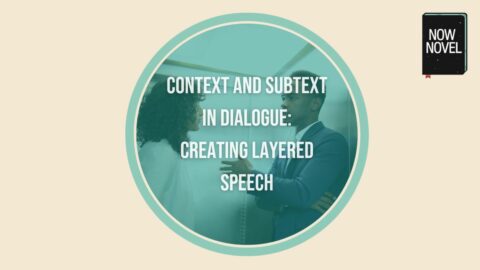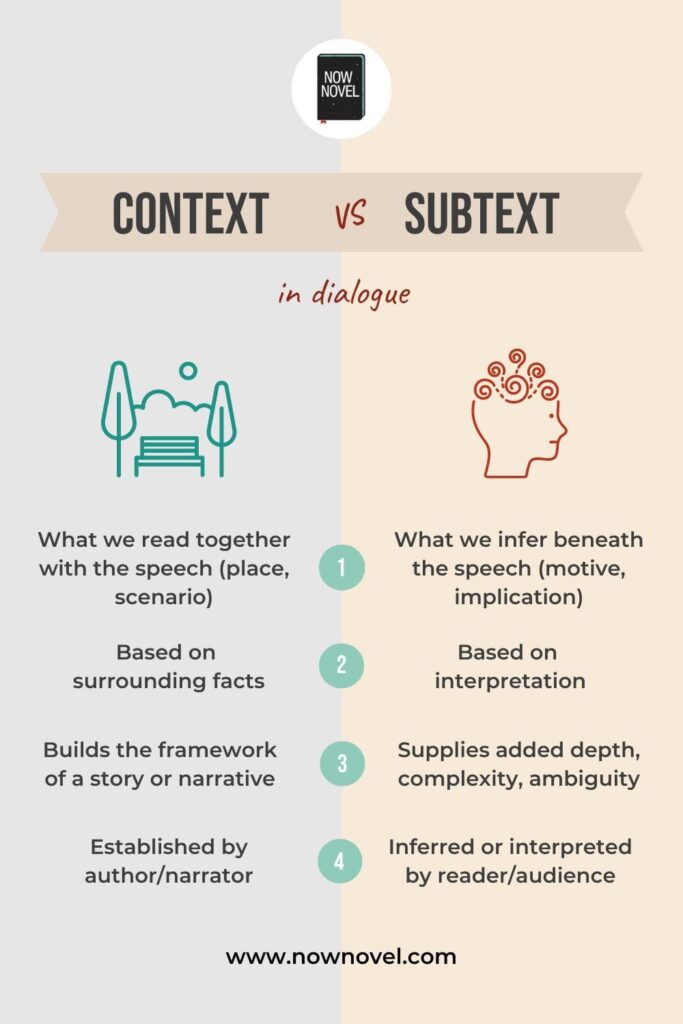Context and subtext in dialogue helps us read place, emotion, motivation and more in speech. Use this guide to context and subtext in dialogue to write communication that comes alive in spoken and unspoken cues.
What is subtext in conversation? Definition and types
‘Subtext’ is what lies ‘beneath’ the text (sub- meaning ‘beneath’ as in ‘submarine’ or ‘substandard’). In other words, subtext is the underlying motivations, feelings, meanings – what isn’t explicitly stated.
It’s one of the elements of human-written dialogue that make it stand out from AI-generated storytelling (as of 2023).
For example, the dialogue tag and action in this example suggest that Martin’s feelings contradict what he’s saying:
“What an amazing day,” Martin said, his affect flat, as he threw himself down to lie on the couch, hoping she’d caught the sarcasm.
The motivational subtext to this dialogue might be that Martin wants someone to notice he’s had a bad day.
The emotional subtext in Martin’s sarcasm suggests frustration, angst. Perhaps the desire to vent or for someone to help him feel better.
What are different types of subtext? Read six types below.
Keep reading for eight types of context in dialogue, too, plus examples of both subtext and context from books. Read our complete guide to dialogue when done for more tips to write meaningful conversation.
Why is subtext in conversation important?
Subtext in dialogue is important because:
- Subtext helps to avoid on-the-nose dialogue. Real communication doesn’t all happen on the surface, in direct statements or questions and answers. People read tone, body language and other ‘sub-‘ layers of communication to understand feeling, inference, shifts and changes
- Subtext makes dialogue feel alive. For example, gestures in dialogue supply a sense of attitude and personality. See Lily’s mother running her finger over a surface to check for dust in the example section below (suggesting a critical nature).
- Subtext aids tension and ambiguity. Inference (such as in Martin implying he’s had a bad day in the example above) creates tension and ambiguity. Often there’s something more than exactly what’s being said going on.
Types of subtext in dialogue
Read definitions of six types of subtext in dialogue:
The unsaid emotions (e.g. anger, joy, fear) which dialogue conveys via tone, gestures, facial expressions, body language, movement.
The inference of what a character wants, their reason to speak. For example, a character who says ‘You know you’re my favorite person, right?’ They might be buttering someone up to ask a favor.
In dialogue, subtextual aspects that suggest power are signs of dynamics such as submission, dominance, control, passivity. Who’s in the driver’s seat, or are the power dynamics balanced?
Unspoken cultural (or subcultural) elements that inform conversation. For example, how a kid familiar with lingo from the video game Among Us may say something’s ‘sus’ to their parents, meaning ‘suspicious’.
Personal subtext in conversation is a speaker’s private history, experiences or backstory. It’s the way these elements shape how a person speaks, responds.
The psychological subtext of conversation refers to psychological processes in dialogue (such as projection – e.g., calling someone a liar when feeling bad about having lied).

GET YOUR FREE GUIDE TO SCENE STRUCTURE
Read a guide to writing scenes with purpose that move your story forward.
Learn moreBefore we explore examples from books, let’s go over context in writing dialogue. What is context, and why does it matter?
What is context in dialogue?
Context in dialogue specifically is what we read ‘together with the text’ (the literal translation of context).
In other words, where the conversation takes place, or events connected to the conversation. The known or previously given information necessary to understand the conversation. The surrounding facts which speech reflects.
To compare context and subtext in dialogue:
- Context is known/given, subtext is more inferred and implied
- Context helps us understand the facts of a conversation, while subtext helps us understand the hidden or implied meaning
- Usually context is more direct and straightforward, not requiring us to pay as much attention to nuance as subtext.
- Context builds a framework for narrative and story (filling in details such as where we are). Subtext, meanwhile, adds layers of complexity and depth
Both context and subtext move and change.
Making dialogue alive with both surface and deeper currents of meaning keeps it intriguing, bristling with tension and possibility.
Tweet This
Why is context in writing conversation important?
Clear context in dialogue is helpful because it:
- Supplies a sense of place and time. Characters are not like talking heads on ‘green screen’, their context disappearing periodically
- Gives cues on expect norms for conversation. For example, an utterance in parliament may be wildly inappropriate, while at a bachelor party nobody would flinch for the same statement. Context shapes our conversational expectations
- Gives cues that infer additional details. For example, a family that discusses art and literature may read as having a higher level of cultural awareness and/or education than a family whose conversation mostly tends towards base topics
Types of context in dialogue
Read eight types of context in dialogue:
The culture or subculture in which a conversation takes place.
Historical context in dialogue refers to elements of historical period or era clarified by speech. For example, how the ‘thees’ and ‘thous’ of Shakespeare tell us we’re in the Renaissance or Early Modern era.
Social context refers to aspects of relationship and connection. For example, weaving in signs in dialogue that the relationship between two speakers is child and parent or brother and sister.
The emotional context of a conversation is the known signs giving how speakers feel. For example, when you use the dialogue tag ‘bellowed’ the contextual detail of increased volume infers the subtext that the speaker is angry, maybe, or trying to be heard above noise.
The physical environment in which a conversation takes place (e.g. on a metro station, next to a public statue).
The language details in a conversation which supply clues about other aspects of context. For example, the way ‘posh’ speech and grammar imply a speaker is privileged or upper-class.
In dialogue, the overt political aspects of conversation, such as the political climate (characters’ conversations about terms such as ‘woke’ in the TV series The White Lotus, for example, situate the story amid contemporary identity politics).
The known personal or historical experiences of a speaker that color how we read what they say (for example, a trauma survivor being triggered by what others say makes sense to us if we know and empathize with their personal context).
Dialogue examples with good subtext and context
Let’s explore examples of effective subtext in dialogue as well as context from books:
Example of emotional, social and situational context and subtext
Here is an example of emotional subtext and social context from Gabriel Garcia Marquez’s Love in the Time of Cholera (literary, historical).
Situational context (the background situation)
Florentino Ariza has been dreaming of unrequited love for Fermina Daza for fifty-one years. Yet Fermina’s husband has only just died. Note how her response suggests the social context of Florentino’s timing being wildly inappropriate. Also the emotional subtext of Fermina reacting to Florentino’s insensitivity to her feelings (having approached her romantically so soon after her husband’s death):
“Fermina, ” he said, “I have waited for this opportunity for more than half a century, to repeat to you once again my vow of eternal fidelity and everlasting love.”
Fermina Daza would have thought she was facing a madman if she had not had reason to believe that at that moment Florentina Ariza was inspired by the grace of the Holy Spirit. Her first impulse was to curse him for profaning the house when the body of her husband was still warm in the grave. But the dignity of her fury held her back.
Gabriel García Márquez, Love in the Time of Cholera (1985), p.50
“Get out of here,” she said. “And don’t show your face again for the years of life that are left to you.” She opened the street door, which she had begun to close, and concluded:
“And I hope there are very few of them.”
Emotional subtext and social context
The emotional subtext is that Fermina is not at all ready to hear romantic proposals. Florentino, on the other hand, has clearly been longing and preparing for this day. Fermina does not need to say ‘I’m not in the headspace for romance’ explicitly for the reader to understand this.
Due to the conversation occurring at Fermina’s husband’s wake, it makes sense that she wants to avoid a dramatic scene. This uses the social context well.
Example of psychological subtext in dialogue
In Virginia Woolf’s Mrs Dalloway, Woolf uses dialogue to show the strain a woman named Rezia is taking. Her husband’s mental health is damaged due to his experiences in the First World War.
Woolf creates a striking sense of the veteran’s turbulent psychological state (and how Rezia struggles to carry this change).
Situational context
Rezia and her husband Septimus are in the park. He has signs of what today we’d call PTSD, plagued by ghostly visions of his dead comrade at arms, Evans. There is a sense of the surrounding stimuli being overwhelming.
This passage starts in Septimus’ POV then Woolf switches to his wife’s viewpoint:
But they beckoned; leaves were alive; trees were alive. And the leaves being connected by millions of fibres with his own body, there on the seat, fanned it up and down […]
Virginia Woolf, Mrs Dalloway (1925), pp. 18-19.
“Septimus!” said Rezia. He started violently. People must notice.
“I am going to walk to the fountain and back,” she said.
For she could stand it no longer. Dr. Holmes might say there was nothing the matter. Far rather would she that he were dead! She could not sit beside him when he stared so and did not see her and made everything terrible; sky and tree, children playing, dragging carts, blowing whistles, falling down; all were terrible. And he would not kill himself; and she could tell no one.
“Septimus has been working too hard” – that was all she could say, to her own mother.
Psychological subtext
Note how the dialogue conveys the subtext of Rezia finding it hard that Septimus is not himself. She scolds and reprimands him (‘Septimus!’). She announces a walk to the fountain. The psychological implication or subtext is that Rezia needs a break from her spouse’s antics.
The most telling subtext that Rezia feels an element of shame and embarrassment is in her words to her mother: ‘Septimus has been working too hard’. There is pathos in the vivid sense of Rezia trying to sweep the troubling changes under the rug.
Example of cultural, social and historical context
Here is example of effective context from Thomas Harris’ Imperium (historical, political drama). The novel is about the famous Roman orator Cicero.
Situational context
Cicero is learning how to be a better orator (skilled public speaker) from Molon, his mentor. (The Times called Molon ‘the first political image consulant’).
We see cultural, social and historical context:
‘But what about the content of what I say?’ Cicero asked.
Thomas Harris, Imperium (2006), p. 9.
‘Surely I will compel attention chiefly by the force of my arguments?
Molon shrugged. ‘Content does not concern me. Remember Demosthenes: “Only three things count in oratory. Delivery, delivery, and again: delivery.”
‘And my stutter?’
‘The st-st-stutter does not b-b-bother me either,’ replied Molon with a grin and a wink. ‘Seriously, it adds interest and a useful impression of honesty. Demosthenes himself had a slight lisp. The audience identifies with these flaws. It is only perfection which is dull. Now, move further down the beach and still try to make me hear.’
Cultural, social and historical context
Culturally, we understand the importance of public speaking skills in life in ancient Rome from this segment.
The social context of referring to predecessors suggests this society’s reverence for tradition and forbears.
Overall, we get a sense of historical context. For example, the important role mentor figures played in this era. The conversation conveys the social value of honesty, and the idea of perfection being ‘dull’ in Roman audiences’ opinions.
Example of subtext with personal and power dynamic aspects
Let’s turn to a different genre and more contemporary example of subtext in dialogue. An example from Colleen Hoover’s It Ends With Us (2016, Romance/New Adult).
Situational context:
College graduate Lily Bloom has moved to Boston. Her abusive father has recently died and her mother has come to visit.
“Oh.”
Colleen Hoover, It Ends with Us (p. 39, Kindle version)
That’s all she says.
My mother turns and assesses the building, running a finger over the windowsill next to her. She picks up a layer of dust and wipes it between her fingers. “It’s…”
“It needs a lot of work, I know,” I interrupt. I point at the windows behind her.
“But look at the storefront. It has potential.”
She scrolls over the windows, nodding. There’s this sound she makes in the back of her throat sometimes, where she agrees with a little hum but her lips remain tight. It means she doesn’t actually agree. And she makes that sound. Twice.
Personal subtext and power subtext
The personal subtext that is clear in the exchange is that Lily is used to her mother being disapproving/critical. Yet she is hoping for more (‘that’s all she says’).
The power subtext here is clearly a difficult mother-daughter dynamic where Lily wants her mom’s validation/approval. Yet her mom is rigid in her own values/standards.
How have you used context and subtext in your own dialogue? Share an example from your WIP or from a favorite book in the comments!
Get feedback on dialogue and scenes weekly, story outlining tools that build a structured outline as you go to download or print, plus writing craft webinars. Start writing with structure and support.






6 replies on “Context and subtext in dialogue: Creating layered speech”
Here’s an example of subtext from my WIP:
I looked at my client. “Good news, Nellie. Your laptop has turned up.”
Nellie’s smile came a little late. “Oh, that’s wonderful,” she blurted. “Thank goodness they found it!” She clasped her hands together in apparent gratitude.
Despite her words and her actions, though, she didn’t strike me as particularly ecstatic.
This is great, David. I like the inference that Nellie doesn’t maybe want her laptop to be found (perhaps worried about what they’ll find on it). It certainly piqued my curiosity. Thanks for reading and sharing this example of dialogue subtext.
I liked this article. It gives writers more clues to consider to help our readers follow along. I think I need to recalibrate my ratio of context to subtext. It’s fun to play with meaning, but if readers don’t understand the situation, what’s the point?
Nice example, @David 😊
That is one of the useful exercises one can do in revision (recalibrating the ratio of subtext to context, as you put it). It is a tricky balance (especially with the experimental or surreal) between giving enough context to anchor story in something concrete and leaving enough inferred through subtext and implication for dialogue not to become too didactic or ‘on-the-nose’. Thanks for sharing your thoughts!
Great post! I use interior monologue as subtext. Also actions that infer a different meaning to what is said. I’m thinking that I’m on the right track. The examples were helpful. Thank you. 📚 Christine
Hi Christine, thank you for your great feedback. It sounds as though you are. Happy writing!